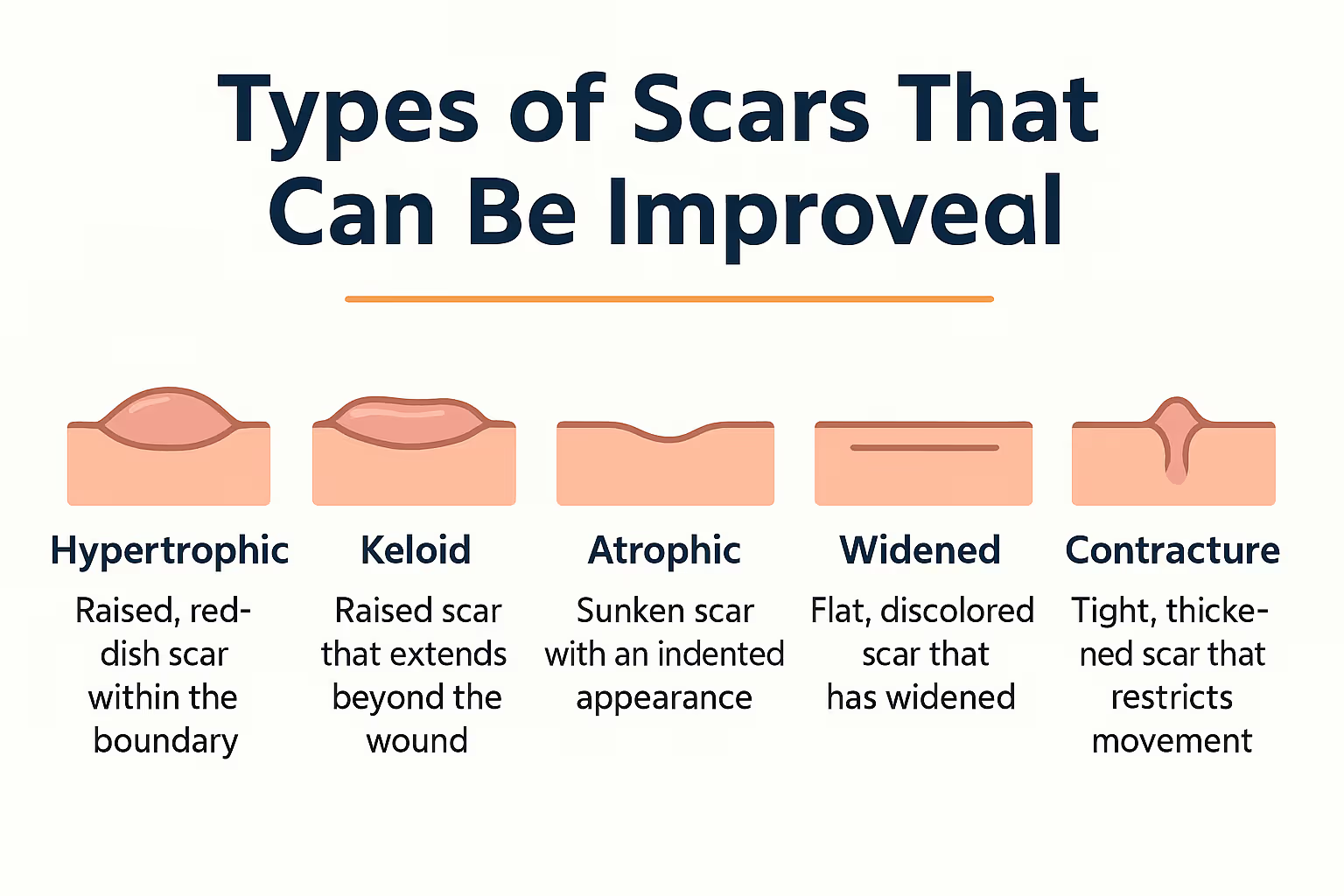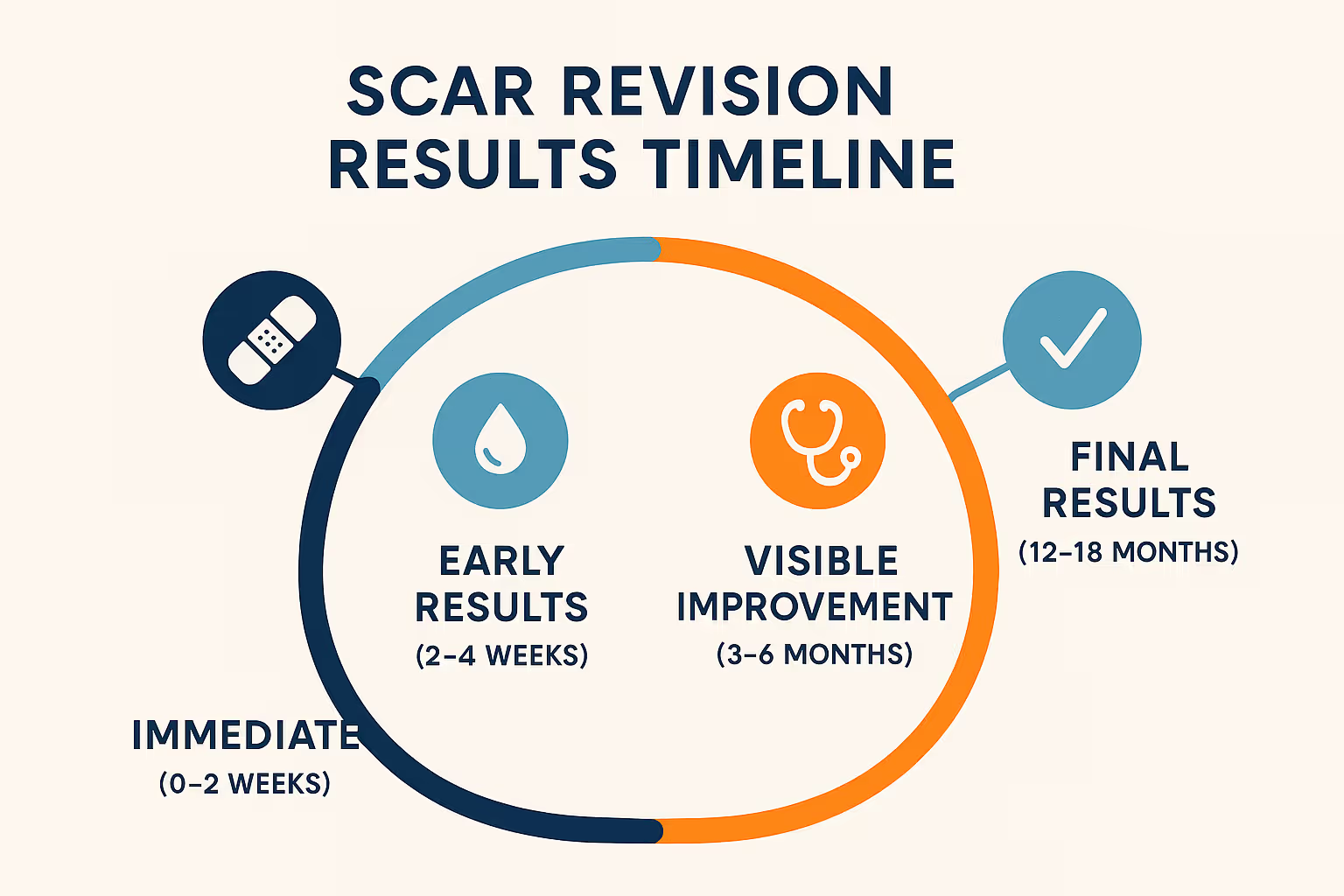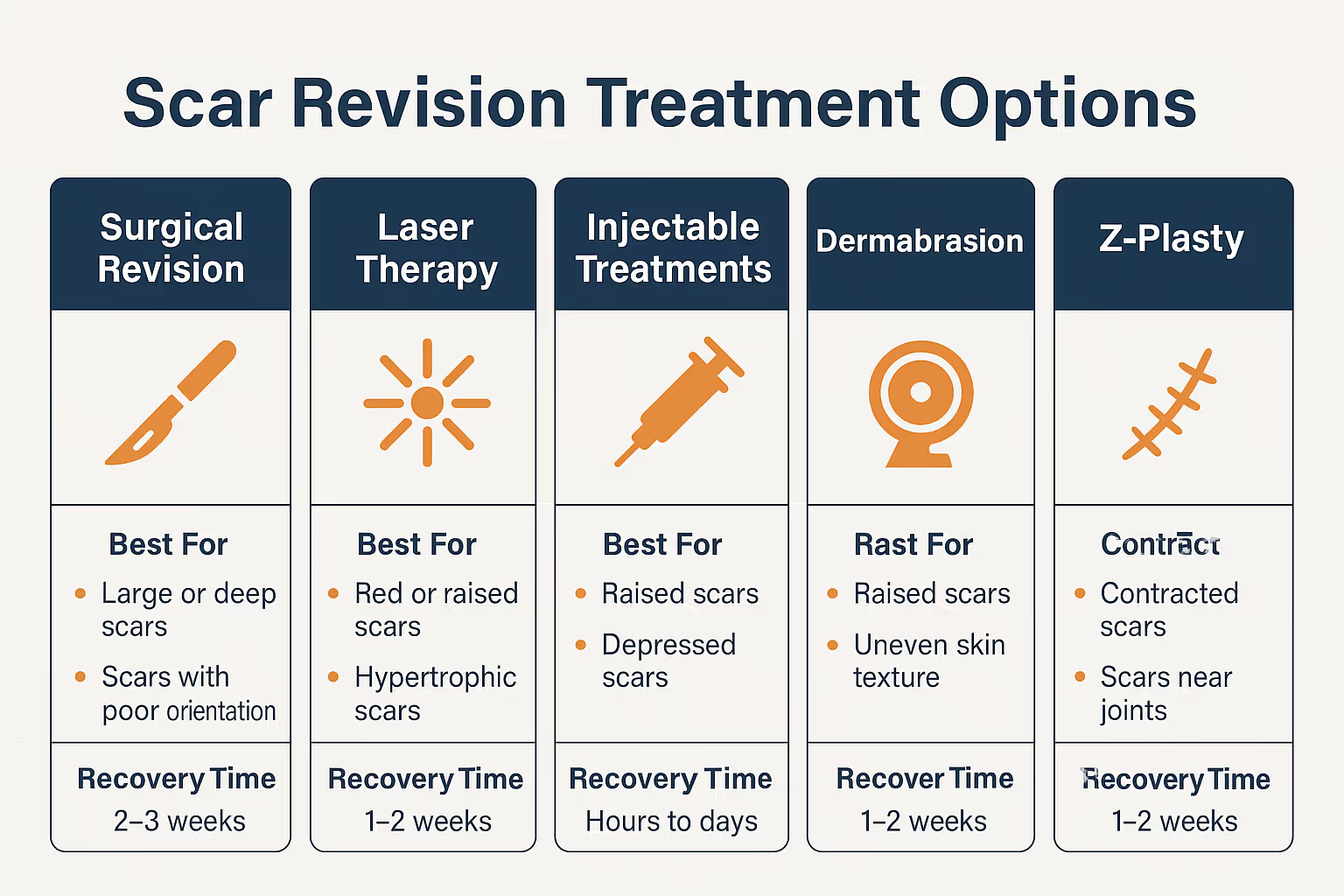You've lived with that scar for years—maybe from childhood surgery, an accident, or an old injury. Every time you catch a glimpse of it, you wonder: Is it too late to do something about this? Here's the truth that might surprise you: old scars can absolutely be improved, and you have more options in 2025 than ever before. Whether your scar is five years old or fifty, modern scar revision techniques can help you feel more confident in your skin again.
Before we dive into revision options, let's talk about what actually happens to scars over time. When your skin heals after injury or surgery, your body produces collagen fibers to close the wound. These fibers form differently than your normal skin tissue—they're typically denser and less organized.
During the first year or two, scars go through several phases:
Early Phase (0-6 weeks): The scar appears red, raised, and may feel tender. This is when your body is actively producing collagen to heal the wound.
Active Remodeling (2-12 months): The scar gradually softens and may begin to flatten. Color often fades from red to pink during this period.
Maturation (12-24 months): Most scars reach their final appearance around 18 months, though some continue changing for up to two years.
Here's what's interesting: older, fully matured scars often respond better to certain revision techniques than newer ones. Why? Because the healing process is complete, which means there's less inflammation and unpredictability when we intervene.
I often hear patients say, "I thought it would fade more over time." While scars do change, they rarely disappear completely on their own. Once scar tissue forms, it's permanent unless we actively treat it.
Several factors determine how your old scar looks today:
The good news? Each of these factors can be addressed through modern scar revision techniques.

Not all scars are created equal, and understanding your scar type helps determine the best revision approach. At The Minor Surgery Center, we commonly treat several categories of old scars:
These raised, thick scars stay within the boundaries of the original wound. They're caused by excess collagen production during healing. Hypertrophic scars often respond well to:
Keloids grow beyond the original wound boundaries and can continue expanding years after injury. They're more common in darker skin tones and require careful treatment to prevent recurrence. We often combine multiple approaches for keloid revision.
These depressed or sunken scars result from tissue loss—common after acne, chickenpox, or certain injuries. Revision techniques focus on building up the depressed area through:
Sometimes scars stretch over time, especially in high-tension areas. These flat but wide scars can be surgically revised and re-closed with techniques that minimize tension on the healing wound.
Burns and other injuries can create tight, restrictive scars that limit movement. These require specialized surgical techniques like Z-plasty or tissue expansion to release tension and improve function.
Modern medicine offers a comprehensive toolkit for improving old scars. Let's explore the most effective options:
This remains the gold standard for many old scars, especially those that are raised, wide, or poorly positioned. During surgical revision, we:
Best for: Wide scars, raised scars, scars in unfavorable positions, contractures
Recovery: 1-2 weeks for initial healing; full maturation takes 12-18 months
Results: Can dramatically improve appearance, though a new (hopefully better) scar will form
Laser technology has revolutionized scar treatment. Different laser types target specific scar characteristics:
Fractional CO2 Lasers: Create microscopic channels in scar tissue, stimulating collagen remodeling and smoothing texture
Pulsed Dye Lasers: Target blood vessels in red or pink scars, reducing discoloration
Erbium Lasers: Gently resurface the skin's surface, improving texture and color
Best for: Textural irregularities, discoloration, mild elevation or depression
Recovery: 3-7 days of redness and peeling; multiple sessions often needed
Results: Gradual improvement over 3-6 months; typically requires 3-5 treatments
For certain scar types, injections offer non-surgical improvement:
Steroid Injections (Corticosteroids): Reduce inflammation and break down excess collagen in raised scars. We typically perform a series of injections spaced 4-6 weeks apart.
Dermal Fillers: Immediately plump depressed scars by adding volume beneath the skin. Results last 6-18 months depending on the filler type.
5-FU (Fluorouracil): Sometimes combined with steroids to prevent keloid recurrence and reduce scar thickness.
These mechanical resurfacing techniques smooth scar texture:
Dermabrasion: Uses a specialized rotating device to "sand down" raised scars or blend scar edges with surrounding skin
Microneedling with PRP: Creates controlled micro-injuries to stimulate collagen production, enhanced with platelet-rich plasma from your own blood
Best for: Surface texture irregularities, slight elevation, blending scar edges
Recovery: 5-10 days for dermabrasion; 2-3 days for microneedling
These surgical techniques reorient scars to follow natural skin lines or release contractures. The surgeon creates small triangular flaps that, when transposed, change the scar's direction by 60-90 degrees.
Best for: Scars crossing natural skin lines, contractures limiting movement, facial scars
Results: Can make scars significantly less noticeable by aligning them with facial expression lines or skin creases
Not every old scar will respond the same way to treatment. Several factors influence your results:
Favorable areas (low tension, good blood supply):
Challenging areas (high tension, prone to thick scars):
People with darker skin tones have a higher risk of keloid formation and post-inflammatory hyperpigmentation. This doesn't mean revision isn't possible—it just requires more careful technique selection and often combination approaches.
If you have a history of poor scarring or keloids, we'll design your treatment plan accordingly, possibly incorporating preventive measures like pressure therapy or silicone sheeting.
Counterintuitively, very old scars (5+ years) often revise beautifully. The tissue is stable, inflammation is completely resolved, and we can predict how your skin will respond. Scars in the 1-2 year range are still maturing, which can make results less predictable.
Conditions that affect healing—like diabetes, autoimmune disorders, or smoking—can impact revision success. We'll assess your health status during your consultation and may recommend optimizing certain factors before proceeding.

Let's walk through what actually happens when you pursue scar revision at The Minor Surgery Center:
During your first visit, we'll:
This consultation is crucial for developing a personalized treatment plan. Every scar is unique, and cookie-cutter approaches rarely deliver optimal results.
For old scars, we often recommend a staged or combination approach:
Example Plan for a Wide, Raised Surgical Scar:
This layered strategy often produces better results than any single technique alone.
Most scar revision procedures are performed under local anesthesia in our comfortable, outpatient setting. You'll be awake but won't feel pain in the treatment area.
Surgical revisions typically take 30-90 minutes depending on complexity. You can go home the same day with detailed aftercare instructions.
Laser treatments take 15-45 minutes and feel like small rubber band snaps against your skin. We apply numbing cream beforehand to maximize comfort.
Injectable treatments are quick—usually 10-20 minutes—with minimal discomfort.
Your commitment to aftercare significantly impacts your final results. We'll provide specific instructions, but general guidelines include:
Here's the reality: scar revision requires patience. While some improvements appear quickly, optimal results take time:
For old scars that you've lived with for years, this timeline is absolutely worth it.
No! We've successfully revised scars that are decades old. In fact, older scars are often ideal candidates because they're fully matured and stable. The tissue isn't actively inflamed or changing, which makes treatment more predictable.
Surgical revision does create a new scar, but it's designed to be less noticeable than the original. We use advanced techniques, optimal closure methods, and strategic positioning to ensure the new scar heals better. Non-surgical options like lasers and injectables don't create new scars.
Honesty is important here: scar revision improves appearance but rarely makes scars completely invisible. Most patients see 50-80% improvement in their scar's appearance. The goal is to make the scar less noticeable, softer, flatter, and better blended with surrounding skin.
Coverage depends on whether the scar causes functional problems (like restricted movement) or is purely cosmetic. Contractures that limit mobility often qualify for coverage. Cosmetic revision typically doesn't. We can help you navigate insurance questions and provide transparent pricing for self-pay options.
Previous unsuccessful revision doesn't mean improvement is impossible. Often, different techniques or combination approaches can succeed where earlier attempts didn't. We'll review what was tried before and develop an alternative strategy.
If you're planning surgery or a procedure in the future, you can take steps to minimize scarring from the start:
✅ Choose an experienced surgeon: Technique matters enormously—proper wound closure prevents many scar problems
✅ Follow post-operative instructions carefully: Keeping wounds clean, avoiding tension, and protecting from sun are crucial
✅ Start scar management early: Silicone sheeting and massage beginning 2-3 weeks after injury can prevent thick scar formation
✅ Optimize your health: Control blood sugar, quit smoking, and ensure good nutrition to support healing
✅ Consider early intervention: If a new scar isn't healing well, don't wait years—early treatment often prevents problems
If you're concerned about scarring from an upcoming minor surgical procedure, discuss scar prevention strategies with your surgeon beforehand.

While every scar is different, here's what many patients report after old scar revision:
💬 "I had a thick, raised scar on my shoulder from surgery 15 years ago. After steroid injections and surgical revision, it's now flat and barely visible. I wish I'd done this years ago."
💬 "My acne scars from my teenage years made me self-conscious for decades. After a series of laser treatments and microneedling, my skin texture has improved so much. I actually feel comfortable without makeup now."
💬 "The keloid on my chest kept growing for 8 years. The combination approach—surgery, injections, and pressure therapy—finally stopped it. It's smaller and softer than it's been in years."
These experiences highlight an important point: you don't have to live with a scar that bothers you. Treatment options exist, and they work.
Consider scheduling a consultation if:
At The Minor Surgery Center, our experienced team evaluates hundreds of scars each year. We'll give you honest, expert advice about what's possible for your specific situation—no pressure, just professional guidance.
Let's talk about something that doesn't always make it into medical discussions: how scars affect your emotional well-being. Many people minimize their feelings about scars, thinking "it's just cosmetic" or "I should just accept it."
But here's the truth: if a scar affects how you feel about yourself, that matters. You deserve to feel confident in your skin. Whether your scar is from an accident, surgery, or old injury, seeking improvement isn't vanity—it's self-care.
Patients often tell us that scar revision gave them more than physical improvement. They report:
These emotional benefits are just as valid as the physical improvements.

Sometimes old scars exist alongside other skin concerns you'd like to address. We can often coordinate treatments for comprehensive improvement:
Scar revision + mole removal: If you have both an old scar and unwanted moles nearby, we can address both during the same treatment period
Scar revision + cyst removal: Old scars and current cysts can be treated in a coordinated plan
Scar revision + skin rejuvenation: Laser treatments for scar improvement can be combined with overall skin texture enhancement
This coordinated approach saves you time and often delivers more harmonious results. You can learn more about the various conditions we treat to see how we might address multiple concerns together.
Let's be transparent about the financial aspect. Scar revision costs vary significantly based on:
During your consultation, we'll provide clear pricing information with no hidden fees. We believe in transparency—you deserve to know exactly what to expect financially before committing to treatment.
Many patients tell us that after years of living with a bothersome scar, the investment in revision was absolutely worthwhile. The confidence and comfort they gained made it one of their best decisions.
If you've been living with an old scar that bothers you, you now know that improvement is possible. Modern scar revision techniques can significantly enhance the appearance of scars regardless of their age.
Here's what I recommend:
1. Schedule a consultation: The first step is simply having a conversation with an experienced professional who can evaluate your specific scar and explain your options. There's no obligation—just information and expert guidance.
2. Ask questions: Come prepared with your concerns and questions. We want you to feel completely informed and comfortable with any treatment decision.
3. Set realistic expectations: Understanding what's achievable helps ensure you're satisfied with your results. We'll be honest about what we can accomplish with your particular scar.
4. Consider timing: While old scars can be treated anytime, think about recovery periods and how they fit with your schedule. Planning ahead ensures the smoothest experience.
5. Commit to aftercare: If you decide to proceed, your dedication to post-treatment care significantly impacts your results. We'll support you throughout the entire process.
The scar you've carried for years—whether it's from childhood surgery, an accident, or an old injury—doesn't have to remain unchanged. Old scar revision offers genuine, proven improvement for scars of any age.
In 2025, we have more effective techniques than ever before: advanced surgical methods, sophisticated laser technology, injectable treatments, and combination approaches tailored to your specific scar type and goals.
The most important thing to remember? You don't have to accept a scar that bothers you. Whether your scar is five years old or fifty, whether it's raised, depressed, wide, or discolored—options exist to help you feel more confident in your skin.
At The Minor Surgery Center, we make scar revision simple, accessible, and stress-free. No long wait times, no confusing medical jargon—just expert care delivered with compassion.
Ready to explore your options? Contact us to schedule a consultation. Let's have an honest conversation about what's possible for your scar. You deserve to feel confident again, and we're here to help make that happen.
Your skin, our specialty—and your satisfaction, our commitment.